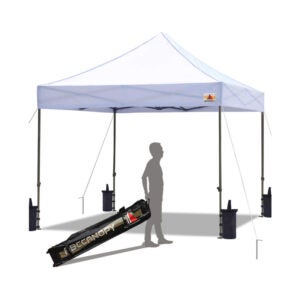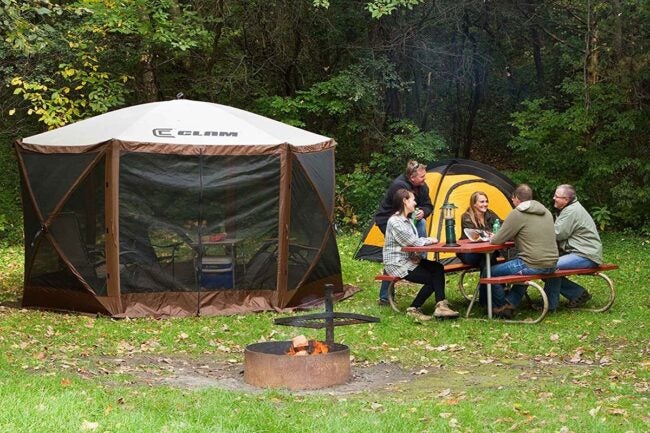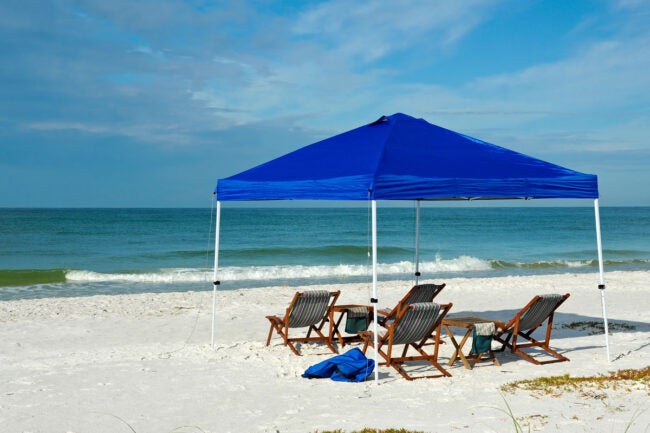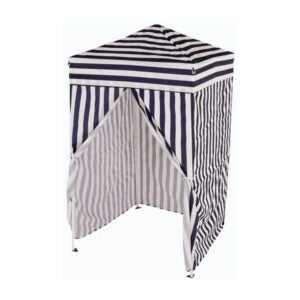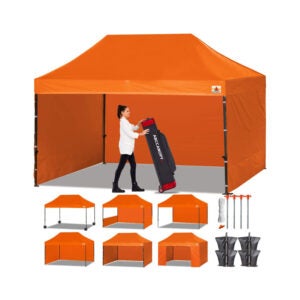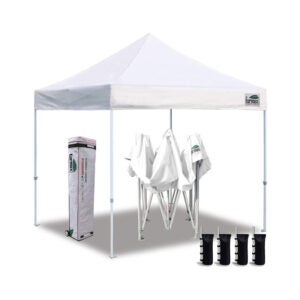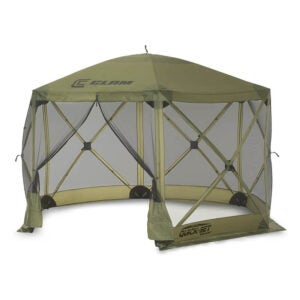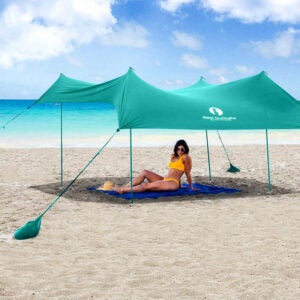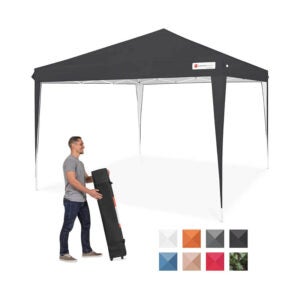Baseball games, days on the beach, and camping trips are just a few of the many times a pop-up canopy comes in handy. These portable sun and rain protectors come in various sizes. Many include features such as mosquito nets, sidewalls, and wheels for added portability. The best pop-up canopy sets up quickly, withstands inhospitable weather, and packs down to a compact size that fits most cars’ trunks.
- BEST OVERALL: ABCCANOPY Pop up Canopy Tent, 10×10
- BEST SMALL SIZE: Impact Canopy 4’ x 4’ Portable Dressing Room
- BEST OVERSIZED: ABCCANOPY Canopy Tent Popup Canopy 10×15
- EASIEST SET UP: Eurmax 10’x10’ EZ Pop Up Canopy Tent
- BEST FOR CAMPING: Quick Set 9281 Escape Shelter Pop Up Tent, 12 x 12
- BEST FOR THE BEACH: Red Suricata Family Beach Sunshade, 10 x 9
- BEST BANG FOR THE BUCK: Best Choice Products Outdoor Instant Pop Up 10×10
The Most Common Types of Pop-Up Canopies
Their material types often categorize pop-up canopies. Polyethylene, polyurethane, polyester, and vinyl are the most common. Each material has its pros and cons, including a higher price point for some. The canopy’s purpose and most common use will help determine the right type of material.
Polyethylene
Polyethylene, a common type of plastic found in plastic bags and plastic bottles, is used to make durable, weather-resistant canopies. It’s waterproof and offers UV protection, yet it’s relatively lightweight. Polyethylene is flammable, so manufacturers typically treat these canopies with a chemical flame retardant.
Polyethylene canopies are a good option for those who regularly need outdoor protection to pack into vehicles. Camping enthusiasts and outdoor vendors are among those who would benefit from such canopies. Some models have sidewalls for added protection.
Polyurethane
Many canopy manufacturers give canopies a polyurethane resin coating that offers some water and sun resistance. The coat usually covers polyester or heavy canvas. Polyurethane does add some weight but is generally lighter than vinyl canopies. This material often costs less than polyethylene or vinyl canopies and offers a balance between durability and price.
Polyester
Polyester is water-resistant and provides some UV protection, though not as much as polyethylene, polyurethane, or vinyl. This lightweight material, which is relatively durable, easily packs down to transport in a trunk. These canopies tend to have smaller footprints and are quite affordable.
Vinyl
Manufacturers of vinyl and polyester canopies often treat the material with a vinyl resin to add waterproofing and UV protection. Of course, waterproofing keeps you dry. UV protection prevents fading, tearing, and material breakdown caused by sun exposure. Manufacturers of wedding tents/canopies and pop-ups meant for more permanent use of vinyl because of their high durability.
On the downside, vinyl is much more substantial than polyethylene, polyurethane, or polyester, making those canopies more challenging to fold down and tote to trade shows or sports events.
What to Look for When You Buy a Pop-Up Canopy
Pop-up canopies are available in sizes that range from small 4-foot-by-4-foot models to wedding canopies that span well over 10-foot-by-20-foot. However, size isn’t the only factor to consider. You want to consider what you need to do to set it up if its size and weight are impediments to transporting it, and what accessories are available.
Size
Canopies come in a wide range of sizes, and most are shaped as squares or rectangles. The smallest models are typically 4 feet by 4 feet designed to shade a single person or something akin to a portable changing station. Pop-ups intended for weddings or other outdoor events typically span 10 feet by 20 feet. Larger canopies leave the realm of pop-up canopies and become pole tents. Of course, the larger the pop-up, the more space you need to transport and store it.
Coverage and Sidewalls
A manufacturer’s design of a pop-up canopy dictates the coverage it provides. Canopies with tall legs and peaked covers offer more vertical space but leave the sides more open, so rain, snow, and sun can leak. Some models include a sidewall or two, while others have attachment points for sidewalls that you can purchase separately. Other models don’t have any sidewall options. Camping pop-up canopies often have bug netting on the sides, so campers can eat or rest free from pests.
Shape
The majority of pop-up canopies are either square or rectangular. However, some models come in unusual shapes like hexagons or octagons. Others are shaped like an umbrella with tie-downs and stakes to secure them. Some models resemble half-dome tents that provide shade without view obstruction.
Stability
Most pop-up canopies come with tie-downs and stakes so you can secure them to the ground. Some models include weighted bags or sandbags that stabilize the canopy. Models designed for the beach may have specially designed stakes that burrow deep into the sand for better stability. Ultra-lightweight models may only have a center pole with a canopy stabilized with several stakes for a less formal but highly portable canopy.
Frame Material
Manufacturers of lightweight frames often construct them from aluminum, while they typically make heavier-duty canopy frames of powder-coated steel. You may want to find a balance between weight and portability. For family trips to the beach, a lightweight aluminum frame can withstand most general uses. Heavier frames tend to be sturdier, but they’re more expensive, more difficult to carry, and may require more than one person to set up.
Water Resistance
Canopy manufacturers use cover materials that have some level of water resistance. You may need to treat polyester with waterproofing sprays to maintain their resilience. Polyethylene, polyurethane, and vinyl offer extra water resistance and UV protection. Most can withstand rain storms without a leak, whereas a polyester canopy may leak if water pools.
Ceiling Height
Higher ceilings allow you to use the canopy without bending over. Canopies designed for use at events typically have a five to twelve-foot ceiling height. Many models also include adjustable legs that offer three to five height options. Camping canopies that look similar to tents have lower, six-foot ceilings. They’re great to use for shade when you sit, eat, or relax, but they’re not meant for people to stand under for long periods.
Carrying Bag or Frame Wheels
Some canopies include carrying bags with straps or handles that allow you to move the canopy. Heavier models may include carrying bags or frames with attached wheels to help you pull the canopy into place.
Budget
Polyester models are typically priced at the lower end of the price range, while polyethylene, polyurethane, and the vinyl canopies run in the higher price ranges. Of course, extra accessories like sidewalls, carrying bags with wheels, and sandbags add to the canopy’s price.
Our Top Picks
The top pop-up canopies are usually made of durable materials and come with the extras that make their designs convenient and easy to use. Read below for some of the highest-rated.
Photo: amazon.com
The manufacturers of the 10-foot-by-10-foot ABCCANOPY Pop-Up Canopy Tent create it from light yet heavy-duty, waterproof polyester that offers UPFF 50+ protection and a rust-resistant steel frame. That frame holds the cover tight even as wind speeds pick up, including stakes or sandbags for stability. The 10-foot-by-10-foot canopy provides enough shade for four tables, three beach chairs, or ten people. This isn’t a lightweight canopy, but the carrying bag includes wheels, making transportation of this canopy easy to manage. The tent can be set up and taken down in seconds, and our canopy sandbags and four stakes and ropes give it extra security. The canopy is available in six sizes and 20 colors.
Photo: amazon.com
The Impact Canopy’s small 4-foot-by-4-foot size makes it ideal for trips to the beach or park, especially when you need to change clothes. The lightweight, polyester fabric is dense so that no one can see through it. The 15 square foot changing area accommodates one or two people. However, that’s not its only use. The four sidewalls provide excellent sun or rain protection for one or two people, and the flaps tie open to view the scenery or watch a game. The canopy and the entire frame fold down to a small 8 inches by 8 inches by 47 inches—small enough to fit inside your car’s trunk.
Photo: amazon.com
This 10-foot-by-20-foot canopy is made of high-quality materials in a sturdy frame with adjustable legs that provide excellent height options. It comes with six side walls and one mesh bug net large enough to cover one wall. The configurations can change based on need, allowing for versatility. For example, on a sunny day, you can have two sidewalls on the backside to provide extra shade while you can use the other sidewalls with the bug net to keep mosquitoes out so you can relax or enjoy outdoor dining. This model also includes stakes and sandbags to stabilize the canopy. While this model is heavy, it comes with a wheeled carrying bag that makes transportation easier. This canopy is also available in 10-foot-by-10-foot and 10-foot-by-15-foot sizes and 17 different colors.
Photo: amazon.com
Eurmax’s thumb button corner sliders lock into place for fast, easy setup. With the press of the same button corner sliders, it easily folds down. The durable full truss structure steel frame is rust-resistant, and the commercial-grade canopy tent is CPAI-84 fire retardant certified 500 denier polyester, coated to block about 99 percent of UV rays. The stitching is sealed to prevent water penetration and to make the canopy genuinely waterproof. The tent has three height positions from 10.5 feet, 10.8 feet, to 11.1 feet. This canopy tent provides up to 100 square feet of shade. It comes with a roller bag for easy transportation. This tent is also available in 10-foot-by-15-foot or 10-foot-by-20-foot sizes and 18 different colors.
Photo: amazon.com
The great outdoors has bugs, extreme sun, and downpours of rain, but that doesn’t mean you need to stay uncomfortable. You can set up this pop-up tent in 45 seconds to protect yourself and your friends from weather and bug infestations. The treated seams resist rain, while stakes and tie-downs offer stability. Hub to hub, the tent measures 140 inches by 140 inches, which is large enough to house a standard picnic table and six to eight people. The manufacturer created it from 210 denier poly-oxford fabric with 600 denier in the center section of the roof and 50+ UV guard protection and bug protection. It also has a No-see-um insect mesh screen, a water-resistant top with taped seams, and triple-layer corner pole pockets. The rigid fiberglass poles hold it in place with the cover attached.
Photo: amazon.com
The Red Suricata qualifies as a minimal pop-up canopy. The versatile design includes four folding aluminum poles with anchor screws that dig deep into the sand. This model offers a two or four-pole configuration for added versatility. With all four poles, up to four adults can lay underneath the canopy. It also includes sandbag anchors and a shovel with which to fill them.
The Red Suricata comes in two sizes, ranging in weight from 7.5 to 9.2 pounds, making it highly portable. On the downside, because it doesn’t have a ready-to-go frame, it takes a little longer to set up than other models.
Photo: amazon.com
Best Choice Products keeps things simple and affordable with their pop-up gazebo, which goes together in a quick, three-step setup process. A wheeled carrying bag, stakes, and tie-downs come as part of the package. This model includes a sturdy, rust-resistant frame and a UV-resistant cover. The size is 115 inches long by 115 inches wide and anywhere from 95 to 102 inches tall. Best Choice designed the tent, so it remains sturdy even in windy weather. Eight color options provide some customization, but there aren’t any sidewall or netting options with this model. If you plan to use this in multiple locations, the simple fold-down system takes seconds to collapse.
The Advantages of Owning a Pop-Up Canopy
Pop-up canopies are popular in the summertime to provide shade. While durable models made with vinyl, polyurethane, or polyethylene resist substantial amounts of rain, provide an escape from unexpected weather. Models with sidewalls may even protect from wind, as long as you stabilize them with stakes or sandbags. With the right accessories, pop-up canopies can also protect from insects and offer some privacy.
Overall, the best pop-up canopies provide:
- UV protection that prevents damage to the skin
- Shade on hot days
- Escape from biting insects
- Escape from unexpected winds or showers
- Privacy in public spaces
FAQ About Your New Pop-Up Canopy
Like every new purchase, it takes some time to learn the ins and outs of pop-up canopies. Here are a few common questions and answers to get you started.
Q. How do you set up a pop-up canopy?
You will find that set up varies from model to model, with some models popping up in a single step. Be sure to read through the instructions before beginning.
The first step is to clear the space in which the canopy will stand. Stand the frame upright, and place the cover over the frame as directed by the manufacturer. Pull the frame and cover outward, then lock it in place when it reaches full-size. Adjust the legs to the desired height and secure the legs with stakes or weighted bags.
Q. How do you anchor a canopy so it doesn’t blow away?
Models that include stakes have them either attached to the sidewalls or tie-downs. Pull the fabric tight, then press or hammer the stake into the ground to stay secure. It helps to angle the stake toward the canopy so that the tie-downs tension from the tie-down keeps the stake anchored.
For models with sandbags, you want to fill the sandbags and place them on the legs or attach them to the tie-downs as directed. You will need to make some adjustments until tie-downs and stakes are at the correct angle.
Q. How much wind can a pop-up canopy take?
The durability and wind resistance varies from model to model. Most canopies, even lightweight models made of polyester or nylon, can withstand light five to ten mile an hour winds without a problem. Heavier materials like polyethylene, polyurethane-coated canvas, and vinyl weigh more, which gives them extra wind resistance. However, unless you securely anchor them, they could blow away.
